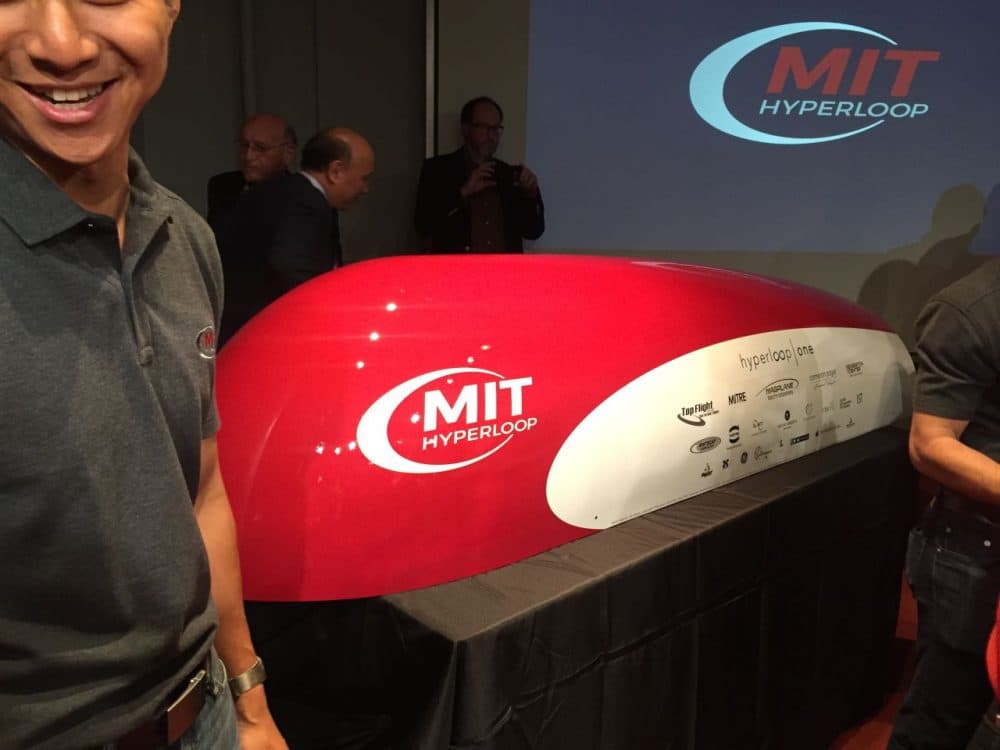Advertisement
MIT Hyperloop Team Reveals Award-Winning Design
Resume
In 2013, Elon Musk, founder of SpaceX and Tesla, proposed a new way to get around. He told PandoDaily, "We've got planes, trains, automobiles and boats for getting around earth. But what if there was a fifth mode...the Hyperloop."
Musk envisioned the Hyperloop as an above-ground tube, with pods traveling at 700 miles per hour. Those pods, he thought, could take a person some 400 miles in just 30 minutes.
This winter, Musk held a national design competition at Texas A&M to see what kind of pods engineers could dream up.
The winner was a team from MIT, and Friday at the MIT Museum they unveiled the design prototype that won the competition.

MIT's Hyperloop is red and white, about eight-feet long, with levitation skis.
The pod is designed to slide along a track inside the Hyperloop tube, but it doesn't touch the track between liftoff and touchdown. The bobsled's skis float thanks to an array of heavy-duty magnets. When it stops, magnetic brakes slow the pod down.
The brakes are among the most difficult and most important aspects of the Hyperloop to get right.
"We’re basically putting a bullet train in a vacuum tube," said MIT team member Charlie Wheeler. He leads the vehicle dynamics team.
That's only if the bullet train went 700 miles per hour — almost the speed of sound. The pod will get its first real tests this summer at Elon Musk's track, expected to be built in California. At the test track, the pods will accelerate at 2 g, though a much longer future track would mean the forces would be felt differently.
The team estimates they’ve spent about $150,000 on the project, and thousands of hours.
"We’ve had so much work to do in the 15 or so weeks since design competition weekend," said Wheeler. "Somehow, it’s all come together really, really smoothly."
Richard Li, a member of the aerostructures team, admitted he worked 20 to 30 hours a week on the Hyperloop.

Fourth-grader Cameron Morgan attended the event with his mother, Lisa Morgan. Morgan said her son has been a fan of the Hyperloop ever since he did a research project on Elon Musk. That excitement, even more than technology, is exactly what the event and competition was about.
"I would argue that the companies that are currently in the Hyperloop field did not rely on this competition in any way for the development of their technology. More so, this competition generated public interest,” said Chris Merian, lead engineer for the MIT Hyperloop team.
But the Hyperloop has already been compared to an earlier revolution in transportation: the airplane.
“Just like planes started off carrying the mail a lot with just the pilot, and then picked up passengers, the Hyperloop will probably be a lot more successful at the beginning carrying cargo to prove it is trustworthy and that it is robust," said the team project manager, John Mayo.
The MIT design may have more influence than they think. Four members, including Merian, will work for Hyperloop One this summer.
Guests
Chris Merian, lead engineer for the MIT Hyperloop team, which tweets @MITHyperloop.
Charlie Wheeler, vehicle dynamics lead for the MIT Hyperloop team, which tweets @MITHyperloop.
Richard Li, member of the aerostructures team for the MIT Hyperloop team, which tweets @MITHyperloop.
John Mayo, project manager for the MIT Hyperloop team, which tweets @MITHyperloop.
More
Radio Boston: MIT Engineering Students Win Hyperloop Design Competition
- "The winning design, out of entries from around the globe, was from MIT."
BBC: Magnetic Hyperloop Pod Unveiled At MIT
- "The MIT team said its pod design paved the way for 'a mode of transportation that could change how we think about travel.'"
This segment aired on May 17, 2016.

